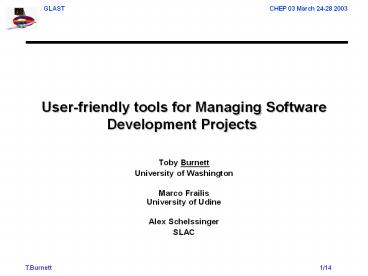User-friendly tools for Managing Software Development Projects - PowerPoint PPT Presentation
1 / 14
Title:
User-friendly tools for Managing Software Development Projects
Description:
User-friendly tools for Managing Software Development Projects Toby Burnett University of Washington Marco Frailis University of Udine Alex Schelssinger – PowerPoint PPT presentation
Number of Views:145
Avg rating:3.0/5.0
Title: User-friendly tools for Managing Software Development Projects
1
User-friendly tools for Managing Software
Development Projects
- Toby Burnett
- University of Washington
- Marco FrailisUniversity of Udine
- Alex Schelssinger
- SLAC
2
Introduction
- Objective make HEP software developers more
productive - HEP software development components
- Package group of related source files, usually
to build a single library and/or executable - Versioning via cvs tags
- Release system to manage and build executables
from set of tagged packages - Development scheme Test area mechanism for
developing and testing new code against a
release. - Observations
- The release/management systems are command-line
oriented, can be daunting to new developers - Hard to get overall view, especially when dealing
with multiple packages
3
The development environment
Package/build manager
Release
User development Area
4
Solutions for CMT
- (Similar approaches would apply to SRT and
scram) - A GUI application
- VCMT (windows and linux versions)
- Simplified command-line interface
- glastpack
5
An OO analysis The players
- Objects
- Environment CMT env vars, etc.
- CMT packages
- system (read-only, sticky tags)
- development (head versions)
- requirements files, sources
- binaries libs, dlls, exes
- Tools
- CMT
- CVS
- development tools
- Windows Visual Studio
- Linux gmake, emacs, gdb/ddd
- Doxygen
6
The strategy
- Present the user with a view of all the objects
- Allow appropriate tools to be used according to
development scenarios - set environment
- checkout packages, singly or in groups
- browse set of available packages
- examine properties of each package, relationships
- modify and rebuild binaries
- check in and/or tag new versions
- run executables
7
We have objects lets define classes
What Class Name Vcmt(windows) implementation
CMT environment Cmt cmt.wsc COM object
A CMT package Package Jscript class Package
Package, its projects, and dependent projects Workspace Jscript class Workspace
Individual binary target Project Jscript class Project
8
The object model diagram
9
A tour of the application
- Examine CMT settings
- Set CMT path
- Browse a packages properties
- requirements file
- used packages
- macros, sets, etc.
- Modify requirements file
- Check cvs status
- Start a console session in the package context
- Checkout a package
- Set up and build a package
- Run a package application
- Start Visual Studio (windows only
10
VCMT for Windows
Text input/output window
11
Structure of the Windows code Jscript and HTML
main program manage objects, GUIrun cvs, visual
studio
Windows Script Host
CMT interface
12
The Linux version
- Written in RUBY
13
glastpack.pl
- usage glastpack.pl create dirname
- usage glastpack.pl help command
- usage glastpack.pl build version
- usage glastpack.pl rco package version
- usage glastpack.pl run package exename
ltargumentsgt - usage glastpack.pl add /path/to/area
- usage glastpack.pl rebuild package
- usage glastpack.pl remove /path/to/area
- usage glastpack.pl co package version
- usage glastpack.pl login
- usage glastpack.pl logout
14
Concluding remarks
- Experience
- In use by all GLAST developers mature, few
problems - it can test for consistency when starting, avoid
installation problems - Package browsing
- Buttons for all basic scenarios
- override CMT behavior (checkout, broadcast)
- Sources
- VCMT/win http//glast.stanford.edu/cgi-bin/cvsweb
-SLAC/vcmt - VCMT/linux http//glast.stanford.edu/cgi-bin/cvsw
eb-SLAC/vcmt4linux - glastpack http//glast.stanford.edu/cgi-bin/cvswe
b-SLAC/glastpack































